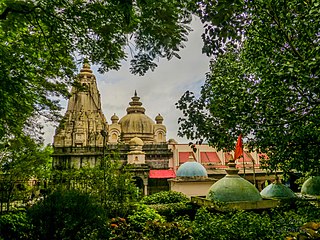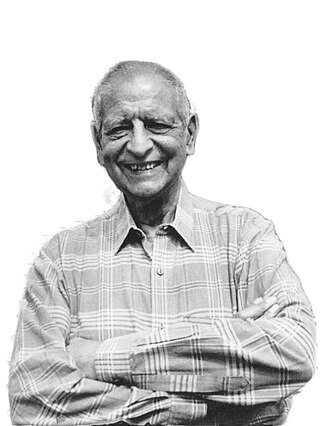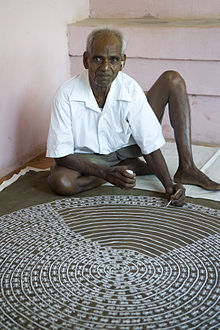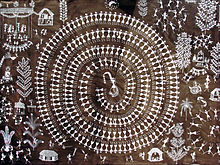
Nek Chand Saini was a self-taught Indian artist, known for building the Rock Garden of Chandigarh, an eighteen-acre sculpture garden in the city of Chandigarh.

Palghar is a town in the Konkan division of Maharashtra state, India and a municipal council. It is in the Mumbai Metropolitan Region, and since 2014 it has been the administrative capital of the Palghar district. Palghar lies on the Western Line of the Mumbai Suburban Railway in the busy Mumbai-Ahmedabad rail corridor. The town is located about 87 kilometers north of Mumbai, about 35 kilometers north of Virar and about 24 kilometers west of the Mumbai-Ahmedabad National Highway at Manor.

Madhubani art is a style of painting practiced in the Mithila region of India and Nepal. It is named after the Madhubani district of Bihar, India, which is where it originated. Jitwarpur and Ranti are the two most notable cities associated with the tradition and evolution of Madhubani art. The art was traditionally practiced by female members of Brahman and Kayastha castes. Artists create these paintings using a variety of mediums, including their own fingers, or twigs, brushes, nib-pens, and matchsticks. The paint is created using natural dyes and pigments. The paintings are characterized by their eye-catching geometrical patterns. There is ritual content for particular occasions, such as birth or marriage, and festivals, such as Holi, Surya Shasti, Kali Puja, Upanayana, and Durga Puja.

Dahanu is a coastal town and a municipal council in Palghar district of Maharashtra state in Konkan division. It is located 110 km from Mumbai city and hosts Adani Power’s thermal power station. It is the site of the approved Vadhawan Deep Water Port.

Sayed Haider Raza was an Indian painter who lived and worked in France for most of his career. Born on 22 February 1922 in Kakkaiya, Central Provinces, British India, Raza moved to France in 1950, marrying the French artist Janine Mongillat in 1959. Following her death from cancer in 2002, Raza returned to India in 2010, where he would live until his death on 28 July 2016.

The Warli or Varli are an indigenous tribe of western India there related ethnic groups are Konkani people, Marathi people. living in mountainous as well as coastal areas along the Maharashtra and Gujarat border and surrounding areas. The Warli have their own animistic beliefs, life, customs and traditions, and as a result of acculturation they have adopted many Hindu beliefs. The Warli speak the unwritten Varli language which belongs to the southern zone of the Indo-Aryan languages. Waralis have sub castes such as Murde varli, Davar varali.

Warli painting is of tribal art mostly created by the tribal people from the North Sahyadri Range in Maharashtra, India. This range encompasses cities such as Dahanu, Talasari, Jawhar, Palghar, Mokhada, and Vikramgad of Palghar district. This tribal art was originated in Maharashtra, where it is still practiced today.
Haku Vajubhai Shah was an Indian painter, Gandhian, cultural anthropologist and author on folk and tribal art and culture. His art belonged to the Baroda Group and his works are considered in the line of artists who brought themes of folk or tribal art to Indian art.

Geeta Kapur is a noted Indian art critic, art historian and curator based in New Delhi. She was one of the pioneers of critical art writing in India, and who, as Indian Express noted, has "dominated the field of Indian contemporary art theory for three decades now". Her writings include artists' monographs, exhibition catalogues, books, and sets of widely anthologized essays on art, film, and cultural theory.

The Padiglione d'Arte Contemporanea or PAC is a museum of contemporary art in Milan, Italy. It is on via Palestro, next to the Galleria d'Arte Moderna, and across from the Giardini Pubblici Indro Montanelli.

Kekoo Gandhy was an Indian art gallerist, art collector and art connoisseur, who pioneered the promotion of Indian modern art from the 1940s. He established Chemould Frames, a frame manufacturing business in 1941, soon he started displaying works of young modern artists K. H. Ara, S. H. Raza, K. K. Hebbar and M. F. Husain in his showroom windows. This led to gradual rise of modern art movement and post-colonial art in India. Eventually Gallery Chemould, India's first commercial art gallery, was opened in 1963 on the first floor of the Jehangir Art Gallery.

Saura painting is a style of wall mural paintings associated with the Saura tribals of the state of Odisha in India. These paintings, also called ikons are visually similar to Warli paintings and hold religious significance for the Sauras.

Sudarshan Sahoo is an Indian sculpture artist from Puri, Odisha. He was awarded India's second highest civilian award Padma Vibhushan in 2021 and India's fourth highest civilian award Padma Shri in 1988.
Chemould Prescott Road, founded, is the first contemporary art gallery in Mumbai, India.

Jangarh Singh Shyam (1962–2001) was a pioneering contemporary Indian artist credited with being the creator of a new school of Indian art called Jangarh Kalam. His work has been exhibited widely the world over including Bhopal, Delhi, Tokyo and New York. His most notable exhibitions include the Magiciens de la terre in Paris (1989) and Other Masters curated by Jyotindra Jain at the Crafts Museum, New Delhi (1998). His 1988 piece Landscape with Spider sold for $31,250 at Sotheby's, New York, in 2010—a first for an adivasi artist. Jangarh had also painted the interiors of the Legislative Assembly of Madhya Pradesh, the Vidhan Bhavan, and the dome of Bhopal's Bharat Bhavan—one of the most prestigious museums of tribal and contemporary Indian art. He was among the first Gond artists to use paper and canvas for his paintings, thereby inaugurating what is now known as Jangarh Kalam.
Biren De (1926–2011) was an Indian painter of modern art, known for his paintings with tantric influences. His paintings were characterized by symmetrical patterns of geometry and the presence of tantric symbols such as mandala, phallus and vagina, reportedly representing masculine and feminine energies of the universe. The Government of India awarded him the fourth highest civilian honour of the Padma Shri in 1992.

Bulu Imam is an environmental activist working for the protection of tribal culture and heritage in Jharkhand. On 12 June 2012, he received the Gandhi International Peace Award, 2011 at the House of Lords in London. He is also a recipient of the Padma Shri (2019). He is the grandson of Syed Hasan Imam, who was a leading Barrister and Judge of Calcutta High Court (1912–1916), and the President of the Indian National Congress. His daughter, Cherry is married to Kunwar Ashish Bir Singh Tekari of Tekari Raj.
Godavari Parulekar was a freedom fighter, writer, and social activist. She was influenced by Marxist and Communist ideologies and spent her life fighting for the farmers and working class. She was married to Shamrao Parulekar, another freedom fighter and activist with the same ideologies.
Godawari Dutta is an Indian painter, well known for Madhubani Painting and patron of Mithila Kala Vikas Samiti. She was awarded India's fourth highest civilian award the Padma Shri.

Sarmaya Arts Foundation is a not-for-profit curated repository of art, artefacts and living traditions from the Indian subcontinent, run by the Sarmaya Trust. Founded by former IndusInd Bank COO Paul Abraham in 2015, Sarmaya is based in Mumbai, India. Sarmaya is a digital museum with a physical collection that represents the diverse histories and artistic traditions of the Subcontinent. Objects in the collection fall into the categories of numismatics, cartography, photography, engravings, modern art, living traditions and rare books.
















